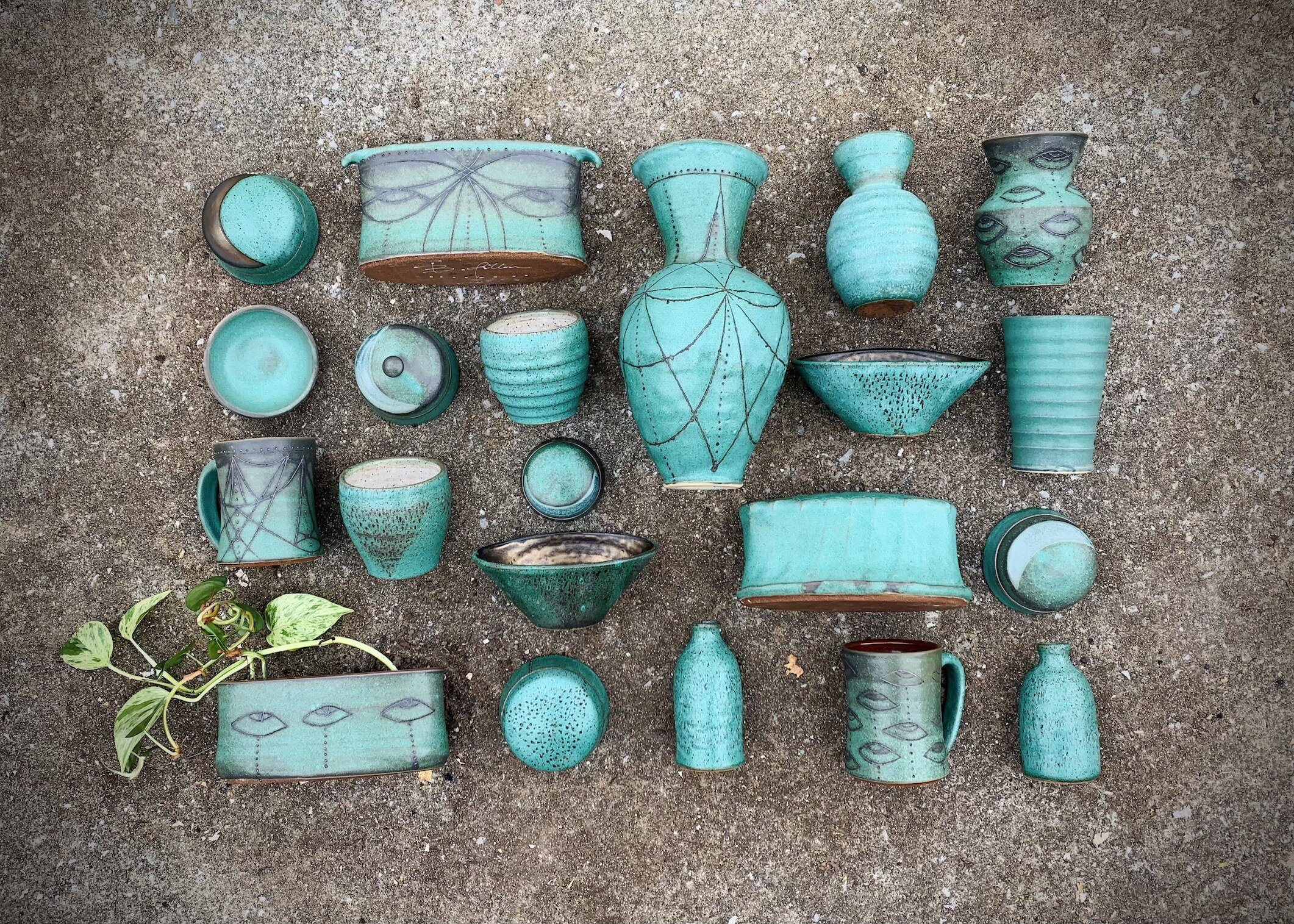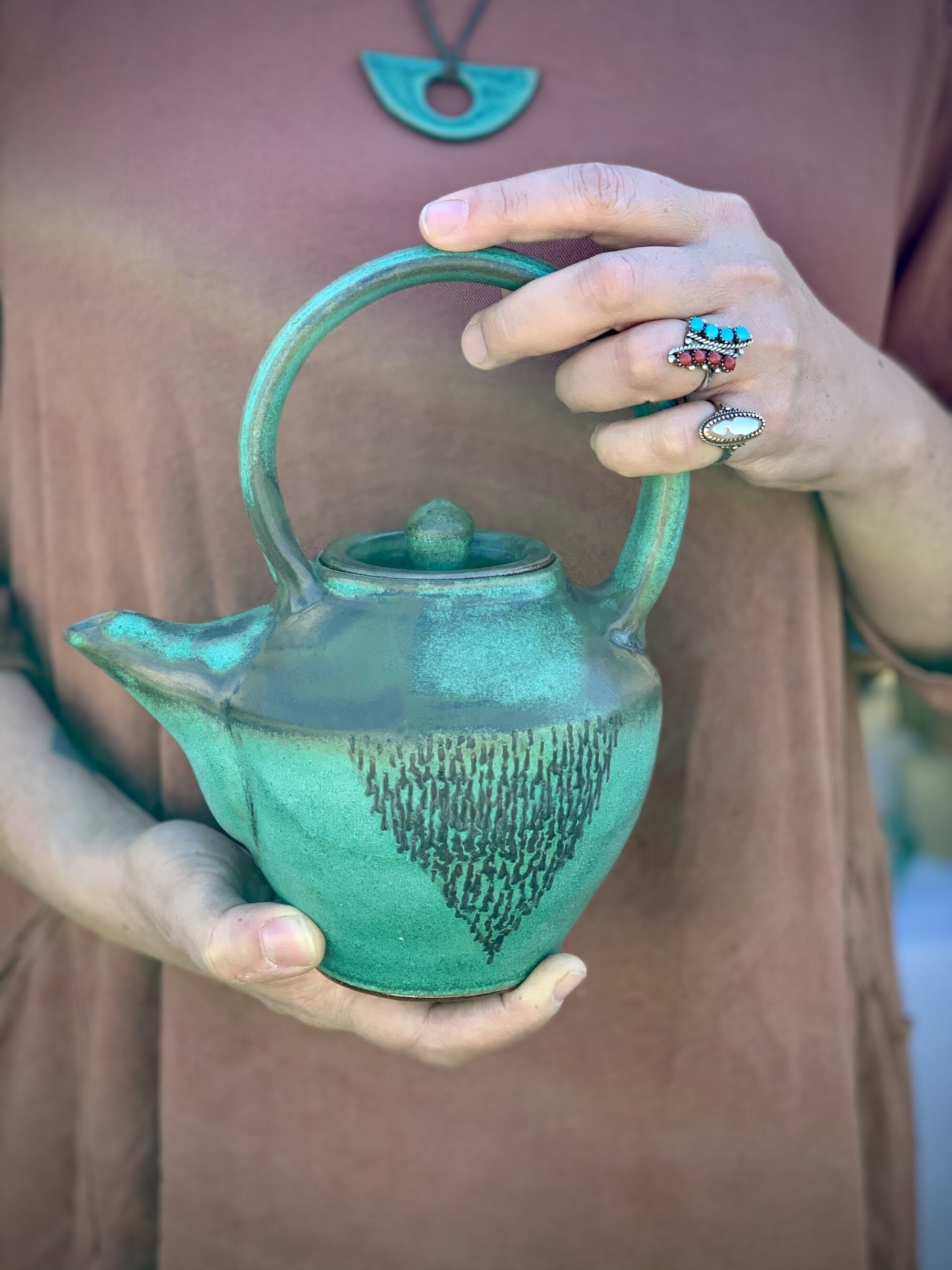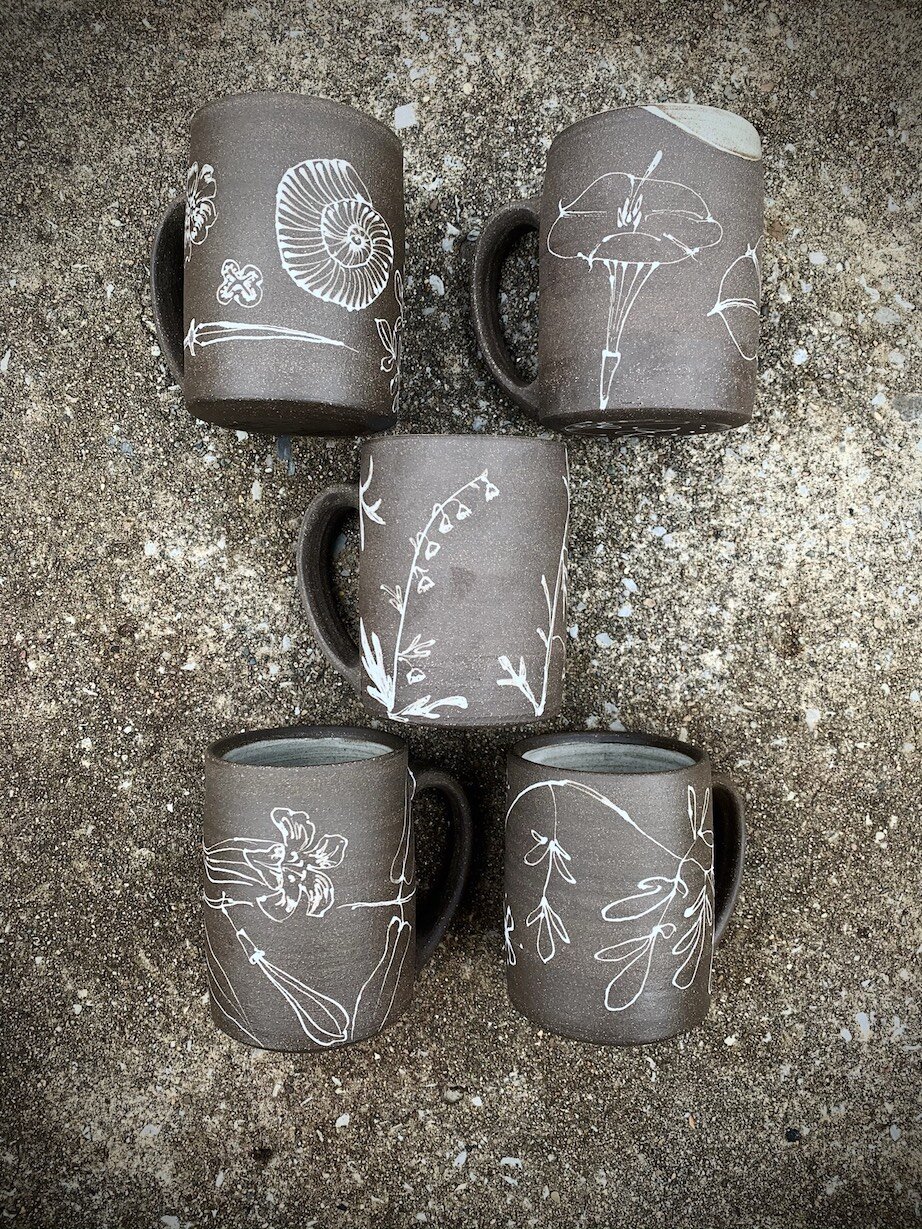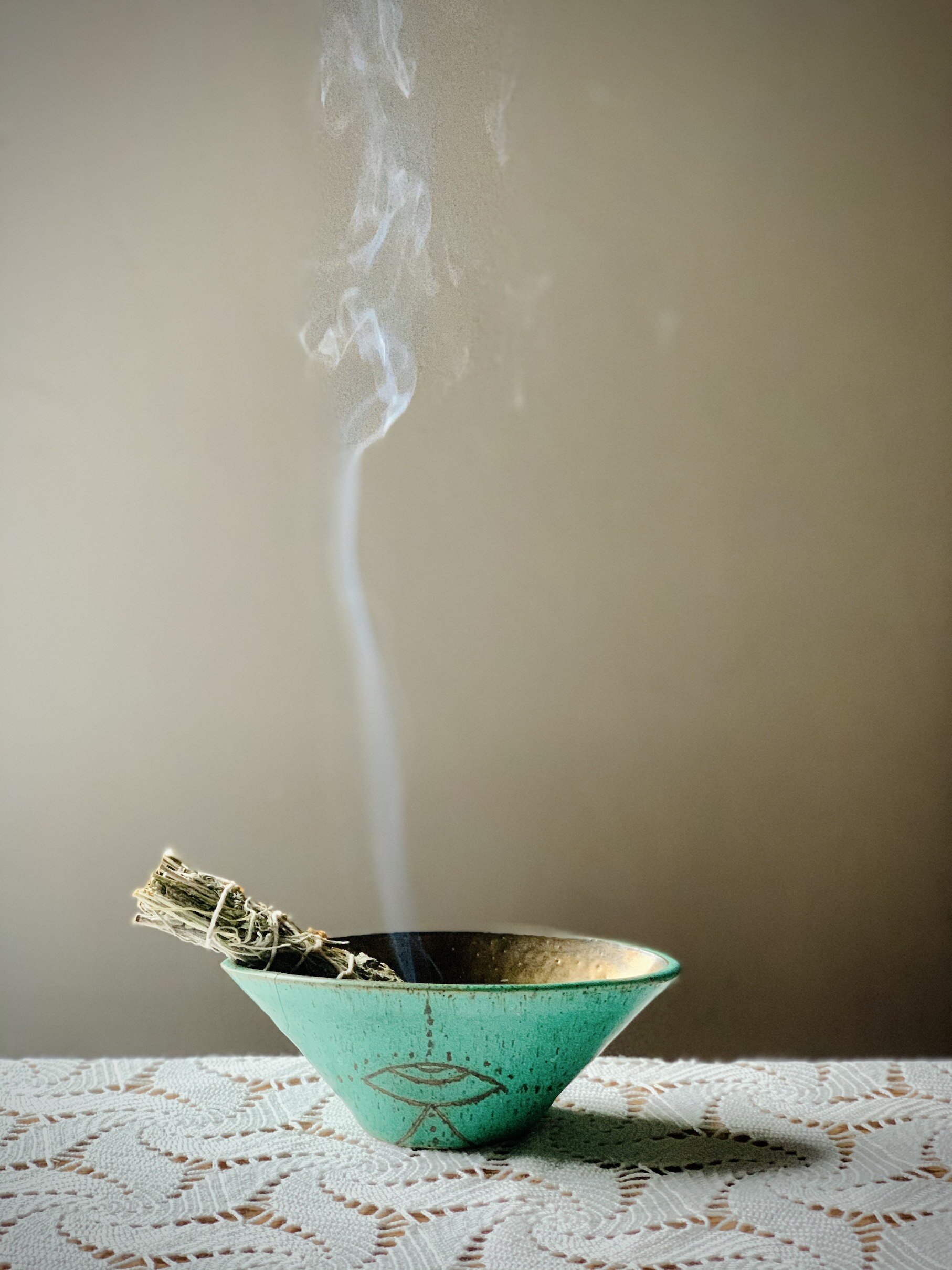Brooke Gillon
Pottery is deceptive. Even the toughest vessels are susceptible to chipping and breakage, and we tend to equate that vulnerability with weakness. But ceramic objects are enduring, not ephemeral. They are, after all, the stuff of archeology. The oldest pottery shards found so far date back some 20,000 years. The pieces of humble vessels and bowls survive longer than pretty much any other human-made product, certainly longer than books, and they speak volumes about their cultures.
Ceramic artist Brooke Gillon creates work that imbues the everyday with beauty and meaning. Her pieces carry an aura of the special — sacred and set-apart, marked with something born of ritual — and yet they’re meant to be used. We sat down with Brooke to dig into where her work comes from, what it means for her, and what we can learn about our own practices from it.
Outer Voice: How did you come to ceramic art?
“In the summer of 2016, I gave myself a pottery class through the local community education program with metro parks. There was a moment that year when I noticed that I was losing myself. Between working full-time, maintaining a home and caring for my family, I had little to no time alone and certainly was not finding time to create anything. Ceramics was especially appealing because of the tactile nature of the work. And truth be told, I really wanted handmade pots and couldn’t afford them.”
What is it about ceramics that speaks to you?
“Ceramics involves amazing alchemical processes that combine earth and water and force and human ingenuity and fire and mineral and time — that alone could be enough to keep me interested forever. There’s also that tactile nature of working in clay which can be so helpful in balancing physical and mental well-being — it’s very therapeutic. But I think the main thing that keeps me coming back to clay is the making of pots as a way of honoring my lineage. A big part of my story is that I come from a long line of Sicilians who find great joy and reverence in the kitchen and in making things by hand. Within this lineage the magic and the mundane are woven together. A clay pot can embody this idea, serving as both a basic part of daily life and, simultaneously, a holy object. The work of cooking, feeding, cleaning, caring and nourishing, or so-called domestic work, is ancestral care work, and nourishing ourselves via handmade vessels is part of praising that sacred work.”
When we spoke before, we talked about how finding pottery and practicing it are a part of your healing journey.
I think as parents or care workers, we tend to neglect our own needs. When I initially signed myself up for that first pottery class, although I didn't realize it at the time, I was responding to a call deep within that was begging me to make time/space for art-making. People need to create — this is one of our deepest expressions of love. Between all of my various commitments, I was really missing that, which is not hard to do under late-stage capitalism. We’re all kept so busy just trying to survive. Giving myself the permission and space to create opened a window for me — it was like a portal into a world where I could begin to see myself more clearly and focus in on my own healing, which continues to be an ongoing journey.
(cont’d after gallery)




You're a very socially/civically engaged artist. You contribute to important causes and have your own reparations practice. What drives you to do that, and what advice would you give other artists?
“I would say I am driven by an orientation towards liberation and a commitment to the work of co-creating a new world that values the sanctity of all life. We are living in a time of multiple pandemics — COVID, food insecurity, rampant state violence, climate collapse and pervasive white supremacy. As a white person living in this time, on this land, within the harmful structures of capitalism that are so deeply lacking in truth and accountability, I have a responsibility to leverage my privilege, wherever it’s found. Owing much of my economic stability to my whiteness, I choose to pay reparations and redistribute unearned wealth made possible by that privilege. And I’m honestly not doing enough. As a general rule, I don’t give advice. I think the sooner we as a society recognize that our individual well-being is tied to the collective whole that includes all life on earth, the sooner we can get to the repair work that is needed to rebuild a better world. We have so much to learn from Black and Brown communities who have always had to build their own networks of resiliency & care for each other in order to survive within this system that does not serve them. I don’t have all of the answers, but I am committed to asking questions and continuing to work towards a just and compassionate world where all beings can thrive.”
We are in a time of beginnings and endings and metamorphosis. What purpose does art serve in this moment?
“I struggle with the notion of art as something that needs to serve a purpose. Art is and always will be of vital importance to human culture. It is a reflection of the fullness of our lived experience. As born creators, it is beyond time for us to embrace art-making as both a regular part of our daily lives and a deeply sacred act.”
I’ve noticed that you use a lot of symbolism in your work. Do those symbols have a particular meaning to you?
“That part of my work is very personal, but basically I have long been fascinated by symbolism and the ways that humans have ascribed meaning to imagery, especially pertaining to the metaphysical. What started out as an interest in the ways that ancient people venerated their goddesses through mark-making on clay vessels, became a practice of creating my own symbolic language, which sometimes included elements of symbolism that I found in my Catholic upbringing or elements of the tarot, which is part of my current spiritual practice. Studying symbolism helped to trace that map to my ancestors, and the way that I decorate my pots has become a conversation between my inner and outer worlds, and includes a lot of the symbolism found among some of these ancestral threads. More recently, I have been making straight plant illustrations on my pots, removing the human-centric aspect of assigning meaning to symbols and just drawing plants in all of their glory.”
Has your art practice helped you to find your voice?
“Yes, I think I’m getting there. It’s true that in order to have a strong sense of ourselves, we have to know where we came from so that we can better understand who we are and where we are going. My clay practice has revealed itself as a roadmap to and from my ancestors. In that way, it has served as a container for a lot of the essential work of healing and self-discovery. Still over here on that trip towards finding my voice, but I think I’m getting closer.”
What's your mission as an artist? Your overarching purpose?
“Hmmm, good question. I aim to fully express and share that which holds value for me and to add to the chorus of a collective cry to slow down. In a world that seeks to expand efficiency at all costs, exploiting the labor of the poor and imprisoned as a means of production, I see the work of making art as a form of resistance.”
Learn more:






